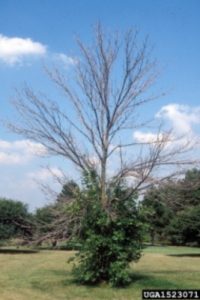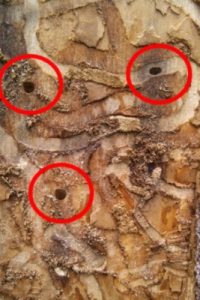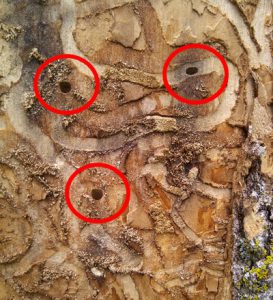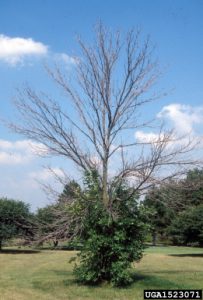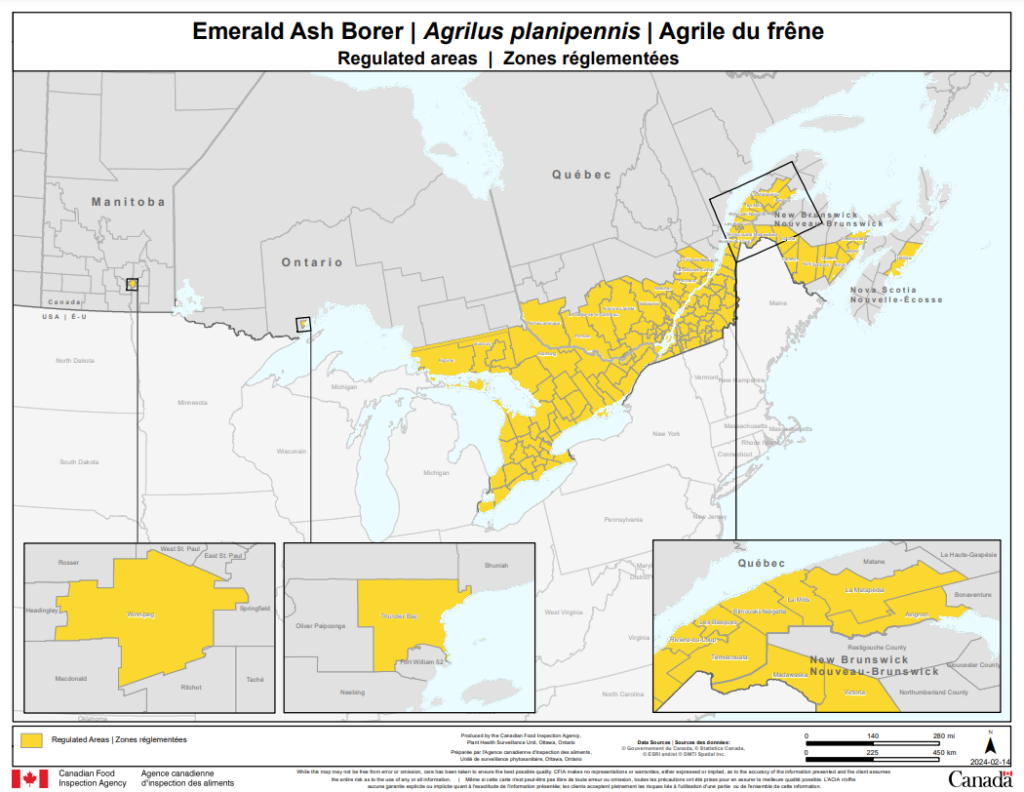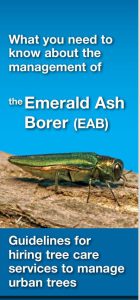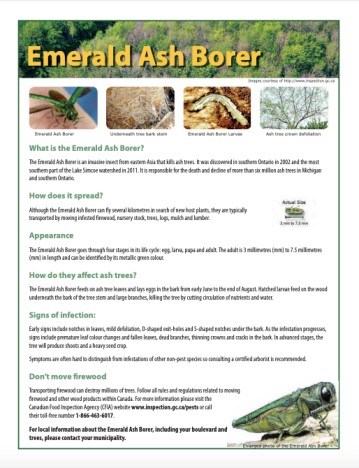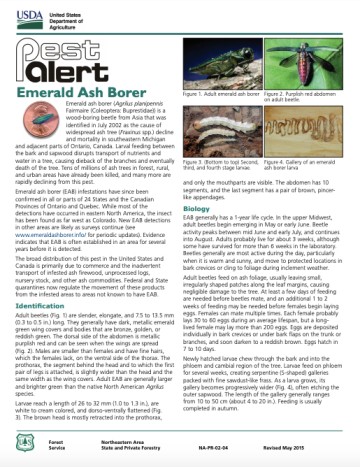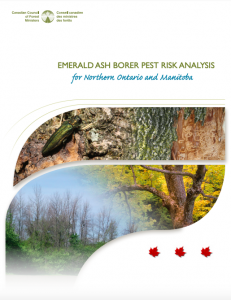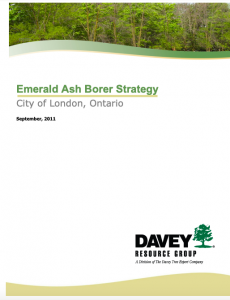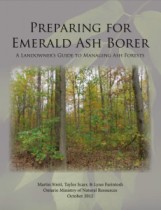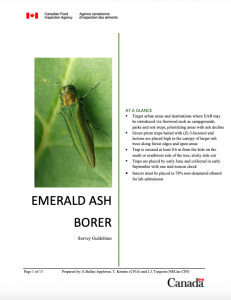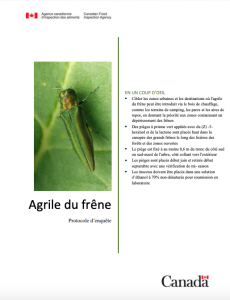Emerald Ash Borer (Agrilus planipennis)
French common name: Agrile du frêne
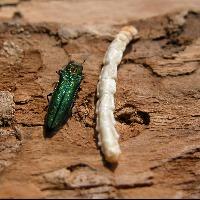
Emerald ash borer adult and pupae.
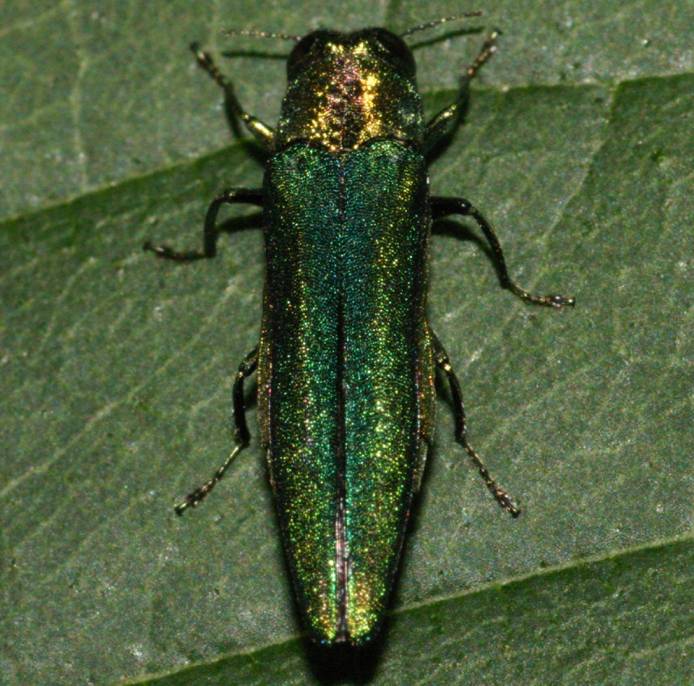
Adults can be about 0.5 in long.
Credit: Jonathan Lelito, BASF Corporation.
Order: Coleoptera
Family: Buprestidae
Did you know? Emerald ash borer can only fly within a 15 km radius.
The emerald ash borer (EAB) is an invasive wood-boring beetle, native to parts of Asia. It was detected in the Detroit, Michigan and Windsor, Ontario areas in 2002, but likely existed undetected in North America since the 1990s. Experts believe the EAB was introduced to Detroit hidden inside wooden packaging materials or shipping crates. Since its arrival, the EAB has been rapidly spreading across North America, having devastating effects on the ash tree population, killing up to 99% of ash trees in its path. The EAB continues to spread in all directions across North America where ash trees are present.
Read the latest updates from the Canadian Food Inspection Agency here.
How to Identify Emerald Ash Borer Infestations
If your ash tree has been infested with the emerald ash borer, you will see several signs and symptoms. These include crown dieback, bark deformities (vertical cracks and shoots growing out of the lower trunk), D-shaped exit holes, woodpecker feeding holes, and yellowing foliage (FIAS, NRCan, 2013). You may also see larval galleries (pictured below, right) beneath the bark.
Physical Description
Adults: Bright metallic green wood-boring beetles, 8 -14 mm (about ½ inch) long and 3-3.5 mm (1/8 inch) wide, body elongated, head flat. The dorsal surface of the abdomen (underneath wings) is usually a bright red colour.
Pupae: 10 -15 mm long, creamy white in colour. As it develops, it takes on adult colouration.
Larvae: 25 – 32 mm long at maturity, creamy white in colour, brown head, flat, broad shaped body; 10-segmented abdomen (bell-shaped segments) and a fork-like appendage on the tip of the abdomen.
Life Cycle
Adult beetles actively feed on host plant foliage throughout their lives. Adults lay eggs in crevices on host tree bark or under bark scales; peak oviposition period typically occurs between late June and early July in temperate regions (Bauer et al., 2004) but may vary depending on factors such as latitude and local climate. To hatch, larvae chew through the side of the egg that is stuck to the bark, and bore into the sapwood, phloem, or cambium part of the bark, where they form pupal chambers and overwinter. When EAB populations become large enough, larval feeding under the bark girdles the tree, eventually leading to tree death. Pupation occurs in the early spring. When development is complete, the adult EAB will chew out of the bark of the tree, leaving a distinctive D-shaped exit hole in the bark (Bauer et al., 2004). Adult EAB begin to emerge from trees in late spring, depending on temperature, and are able to fly immediately after emergence.
Cold Tolerance
Previous research indicated that EAB larvae could not survive below -35.3 C. However, EAB may still be able to survive these cold conditions based on several specific factors and recent research into phenotypic plasticity indicates they could survive temperatures that are much colder. Phenotypic plasticity is the ability of an organism to change its traits in response to the environment without the need for changes at the genetic level. Extreme phenotypic plasticity of cold tolerance allowed the EAB in this new study to adapt to Canadian winters and survive temperatures as low as -50 C! These findings mean that EAB have the potential to survive some of the harshest winters in regions where their host trees grow.
EAB attacks and kills all species of North American ash (Fraxinus spp.) that it has encountered. A total of 20 species of ash are found in North America, six of which are native to Canada: green ash , white ash, black ash, and much less common blue ash, pumpkin ash, and Oregon ash in B.C. Blue ash may succumb to EAB, however, research indicated that it is mostly resistant. Recent evidence from the U.S. suggests that EAB may also attack the white fringetree.
How to Identify an Ash Tree
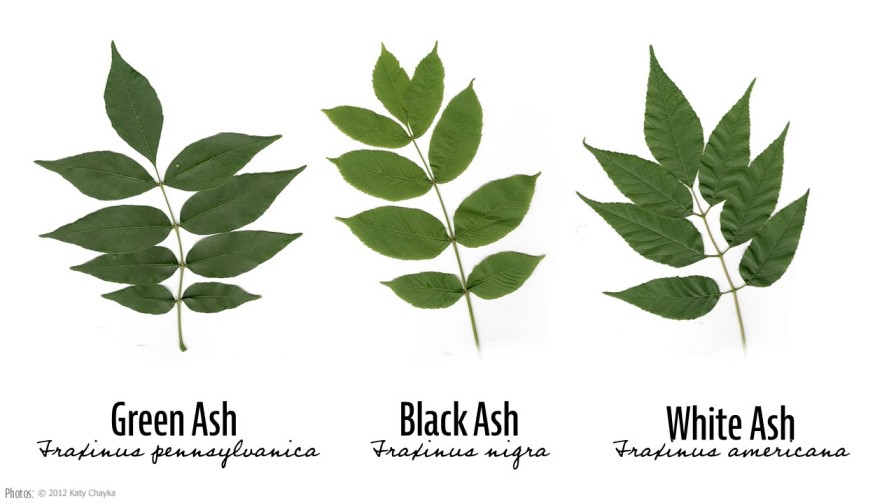
Signs and Symptoms Include:
- Crown dieback
- Bark deformities
- Woodpecker feeding holes
- D-shaped exit holes in the tree
- Epicormic branches (shoots that typically grow out of the lower trunk, but can be found on all parts of the trunk or branches)
- Yellowing of foliage
- Vertical cracks in the trunk
Photo: Taylor Scarr, OMNRF (edited). Galleries formed under the bark from EAB larval feeding. D-shaped exit holes are circled in red. |
Photo: Daniel Herms, The Ohio State University, bugwood.org. Typical signs of EAB infestation include crown dieback and epicormic branches. |
Initial surveys in 2002 revealed the presence of EAB in seven counties in Southeastern Michigan. EAB has been detected in 35 states in the U.S. and 5 provinces in Canada (Ontario, Quebec, Manitoba, New Brunswick and Nova Scotia), and continues to spread. The United States Department of Agriculture’s (USDA) Animal Plant Health Inspection Service (APHIS) updates and distributes an Emerald Ash Borer (EAB) (Agrilus planipennis Fairmaire) Detection Map each month; click here to see the current map. In an attempt to control the spread of EAB in Canada, the Canadian Food Inspection Agency (CFIA) has developed regulations that restrict the transport of ash materials (such as firewood) out of affected areas, under the Plant Protection Act (CFIA, 2011).
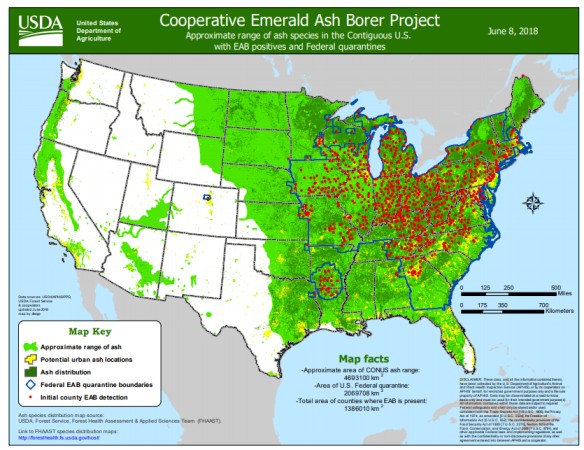
Map: U.S. Department of Agriculture (June 2018).
https://www.aphis.usda.gov/plant_health/plant_pest_info/emerald_ash_b/downloads/AshRangeMap.pdf
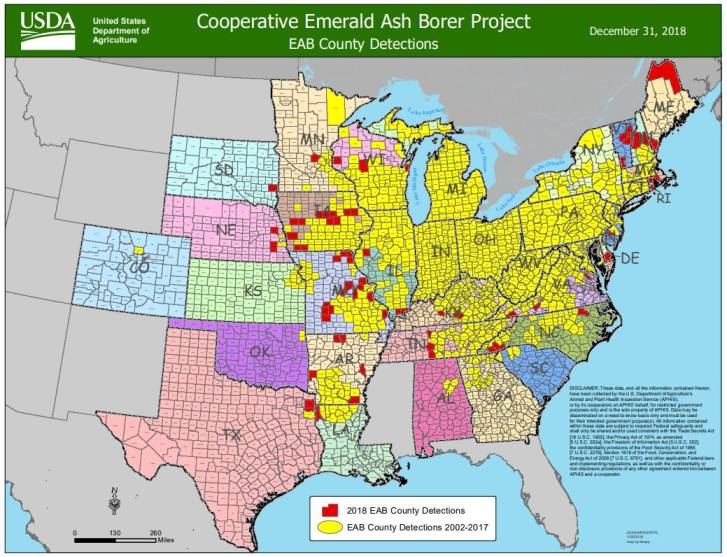
Map: U.S. Department of Agriculture (December 2018).
The map below is the EDDMapS (Early Detection & Distribution Mapping System) Ontario distribution map for the emerald ash borer as of May 2018.
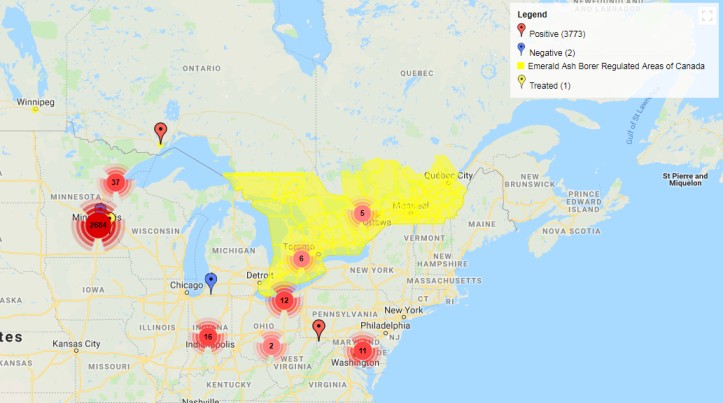
Map: EDDMapS. 2018. Early Detection & Distribution Mapping System. The University of Georgia – Center for Invasive Species and Ecosystem Health. Available online at http://www.eddmaps.org/; last accessed June 25, 2018.
There are federal regulatory measures in place that strive to reduce human-mediated spread of EAB and contain their populations to infested areas. These regulations prohibit the movement of specific materials, such as ash material and firewood of all species, from specific infested areas of Ontario, Quebec, and Winnipeg, Manitoba (see below). Violating these restrictions could result in fines and/or prosecution (CFIA, 2014) .
Emerald Ash Borer Regulated Areas of Canada
Map: CFIA (2024)
For more information on EAB regulation, please visit the Canadian Food Inspection Agency (CFIA) website by clicking here.
The following CFIA policies relate to EAB:
Canadian Wood Packaging Import Requirements
Plant Protection Policy Documents
Emerald Ash Borer Approved Facilities Compliance Program
Economic Impacts
Ash trees provide many benefits within urban environments, such as increased property values, windbreaks, temperature regulation, pollution abatement, runoff prevention, and provision of wildlife habitat. With extensive ash tree mortality caused by EAB, the cost of replacing such services can be immense for municipalities. Further, the cost of treating infested trees, removing damaged and dead trees, and replanting where trees have been lost have already been very large (NRCan, 2014). You can calculate the cost estimate of treating vs. removing your ash tree by visiting the Canadian Forest Service Ash Projection Model (CFS-APM).
The City of Toronto, for example, estimates that it will cost the city $37 million over five years to cut and replace the city-owned ash trees that are killed by the insect. Further, as of 2012, the Canadian Food Inspection Agency had already spent over $30 million to manage the invasion of EAB and had cut over 30,000 trees to slow the spread of the beetle (Ontario Ministry of Natural Resources, 2012). Over the next decade, some estimates suggest that 17 million trees will need to be removed and replaced within communities in the U.S. alone. This would cost approximately $10.7 billion, but could double if both urban and rural land is taken into account (Kovacs et al, 2010).
Ash is also commonly used for commercial lumber, pulp, tool handles, furniture and crating (Cappaert, 2005). Loss of ash could have a significant impact on these industries. As described in Poland and McCullough (2006), ash comprises approximately 7.5% of total hardwood saw-timber volume in the U.S., with a stumpage value of at least $25.1 billion (Federal Register, 2003).
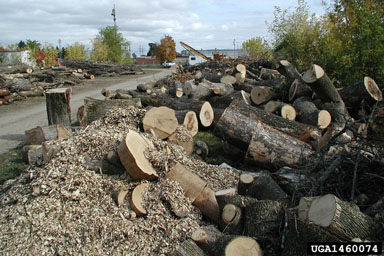
Photo: David Cappaert bugwood.org
Ash trees removed from an urban area in response to an emerald ash borer infestation. Urban tree removal comes at a high economic and ecological cost for municipalities across infested areas. The City of Toronto alone anticipates costs of $37 million to cut and replace ash trees throughout the city, resulting in loss of aesthetic value to neighbourhoods, and a loss of ecological services that the trees provide.
Ecological Impacts
Emerald ash borer has already done extensive damage to ash tree populations in North America, killing millions of ash trees in Ontario, Quebec, and many U.S. states.
Although the direct effects of EAB on ash trees are fairly conspicuous, the indirect or downstream ecological impacts of EAB are much more difficult to quantify. Some potential ecological impacts are as follows: changes to forest structure, altered canopy gaps, reduced coarse woody debris, altered biogeochemical and nutrient cycling, and altered ecological interactions among organisms (both aquatic and terrestrial). Specifically, populations of native species that have specialized interactions with the threatened host, such as terrestrial arthropod species with a high level of association with ash, might be at increased risk (Gandhi and Herms 2010). Poland and McCullough (2006) suggest that the loss of green and black ash, which dominate riparian corridors and poorly drained sites, respectively, could produce the most significant ecological impacts.
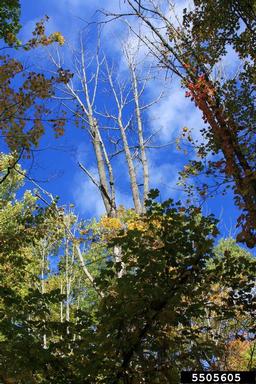
Photo: Steven Katovich, Bugwood.org
Canopy openings caused by EAB damage can increase light penetration to the forest floor, and make the area more susceptible to understory plant invasions.
Social Impacts
The aesthetic and recreational values that people place on forests and parks could be negatively impacted by EAB, since many ash trees within these natural areas have already died, or are susceptible to EAB infestation. Ash is a commonly planted street and park tree, and the loss of mature trees will negatively impact the aesthetic value of residential neighbourhoods and urban greenspace.
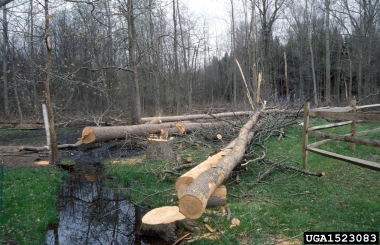
Photo: Daniel Herms, The Ohio State University, Bugwood.org
A mature ash tree is removed from a residential neighbourhood after being attacked by the emerald ash borer. Urban areas are at high risk to EAB infestations, as ash trees line many streets, and are commonly found in parks, and urban greenspace.
In Ontario, EAB has become well established and its distribution continues to increase from natural spread of the insect flying from tree to tree and from human-mediated spread through movement of infested ash materials. Management efforts no longer focus on eradication of the insect from Canada, as this is not a realistic outcome. Control efforts are focusing on slowing the spread of EAB and striving to contain the infestation to currently infested and quarantined sites (NRCan, 2013).
Prevent
Prevention of an emerald ash borer infestation in a new area is the most effective way to reduce long-term impacts. To assist in preventing an EAB infestation, follow these tips:
- Don’t move firewood, as EAB larvae could be hiding inside
- Learn to identify an EAB, its signs and symptoms
- Spread the word: educate family and friends of the potential threat
- Report any sightings
Detect
Detection is an essential step once emerald ash borer is suspected to be in a new area. Quick detection and identification of the pest allows for rapid response and treatment.
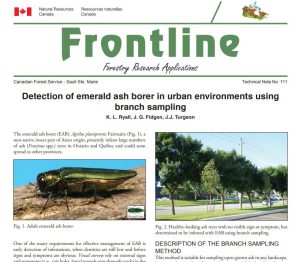
There are two main methods of detection used for emerald ash borer:
1. Detection Trapping
Detection traps baited with plant volatiles and/or pheromone lures are placed on host trees, and if EAB is present in the vicinity of the tree, individuals may become trapped, and collected by surveyors.
2. Branch Sampling
Branches are removed from a potential host tree, and inspected using specific guidelines for the presence of EAB larvae below the bark. Branch sampling allows for detection of the pest even at low population densities.
Learn how to perform both of these detection methods using the instructional videos below:
Branch Sampling for Emerald Ash Borer
Learn how to detect an emerald ash borer infestation using the branch sampling technique
For more information on branch sampling for EAB, see Detection of emerald ash borer in urban environments using branch sampling (Ryall et al., 2011)
Respond & Control
There are several control methods currently being used to contain EAB to infested sites within Southern Ontario:
Mechanical
EAB infested trees can be cut down and their wood either burned or buried. This method is used particularly where the infestation centre is small, and strives to reduce EAB populations and slow their spread to surrounding areas (NRCan, 2013).
Chemical
In Canada, chemical control of EAB is undertaken using a systemic insecticide with one of three active ingredients (imidacloprid, acephate, and azadirachtin) which is directly injected into the trunk of a recently infested tree, or a tree that is susceptible to infestation (NRCan, 2013). There are four injectable insecticides registered in Canada for use against EAB. These chemicals are injected into the tree trunk and are then transported in the conductive tissues (xylem and phloem) upwards through the tree. Even if a tree is injected with the insecticide, it may take several years to fully recover from the EAB infestation, and re-treatment may be needed to prevent additional infestations. For best results, the insecticide should be injected prior to infestation, or as soon after infestation as possible, and during adult EAB emergence in the late spring or early summer (OMAFRA, 2013)
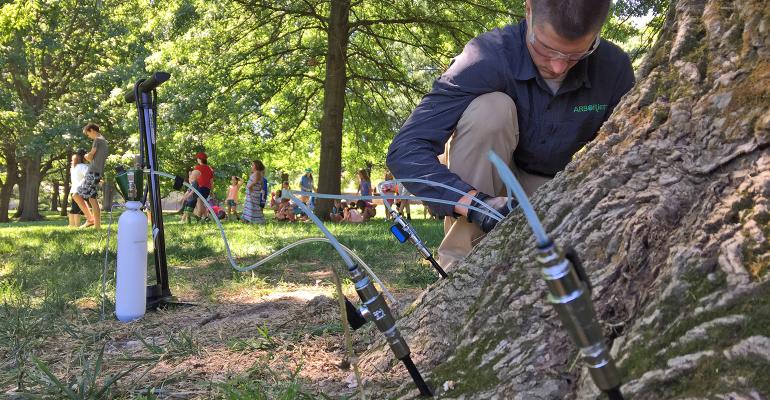
Biological
In Canada, four species of wasps have been approved for use as biological control agents of EAB. These parasitoids are being used in an attempt to control the spread of EAB and to reduce its population. Three species have been released in Canada (Tetrastichus planipennisi, Spathius galinae, and Oobius agrili), the fourth species (Spathius agrili) has not been released as research has shown it would not be able to successfully establish a population in a Canadian climate. These wasps do not sting humans and their impacts on other native species are being closely monitored after release (CFIA, 2013).
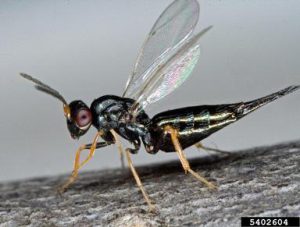
Photo: David Cappaert, Bugwood.org
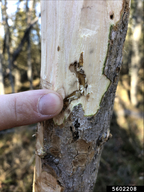
 Photo: Bill McNee, Wisconsin Dept of Natural Resources, Bugwood.org
Photo: Bill McNee, Wisconsin Dept of Natural Resources, Bugwood.org
The Eulophid wasp (Tetrastichus planipennisi), pictured above, is being released for biological control of EAB.
Fact Sheets
Management Resources
Research
Emerald ash borer: invasion of the urban forest and the threat to North America’s ash resource
ash trees in southeastern Michigan and Windsor, Ontario, in 2002. Like several other
invasive forest pests, the EAB likely was introduced and became established in a highly …
[PDF] Emerald ash borer in North America: a research and regulatory challenge
Pest Advisory Group by USDA APHIS in mid-July. Natural resource and regulatory officials
from federal and state agencies met in southeastern Michigan to observe and discuss the …
Emerald ash borer invasion of North America: history, biology, ecology, impacts, and management
Fairmaire (Coleoptera: Buprestidae), has killed millions of ash trees in North America. As it
continues to spread, it could functionally extirpate ash with devastating economic and …
Insecticide options for protecting ash trees from emerald ash borer
advanced since this bulletin was initially published in 2009. This version has been revised to
address frequently asked questions and reflect the current state of understanding of …
Current Projects
Further Reading
The Invasive Species Centre aims to connect stakeholders. The following information below link to resources that have been created by external organizations.

